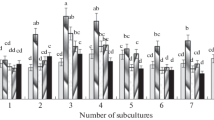Summary
Four strains of tobacco callus culture were investigated karyologically. These cultures were started by Gautheret. Two of them are auxin-autotrophic, the one, Tc, was induced by Agrobacterium tumefaciens to a crowngall tumor, the other, Ta, originated by habituation. The cultures of these strains were started in 1946. The two “normal” strains (Tn1 and Tn2) are auxinheterotrophic. They date back to 1961.
All four strains are polyploid. In each of the cultures there exist more than one level of ploidy; i.e., they are mixoploids to a greater or lesser degree.
A change in the composition of the culture medium with respect to auxin-kinetin-content alters the distribution of the different grades of ploidy in the cell-populations. However, the four cultures do not respond in the same way to a particular modification of the substrate.
The strains Tn1 and Tn2, which are heterotrophic for growth substances, are mainly tetraploid. The autotrophs Ta and Tc, which grow as tumors after transplantation on healthy plants, are mainly triploid.
The discussion of this result together with those of FOX renders it probable, that the correlation of the approximately triploid chromosome number to auxin-autotrophy after a prolonged culture period is a real one. According to subsequent discussions together with the findings of other workers and under consideration of regenerated plants from auxin-autotrophic cultures (to be described later) it seems more probable but not definitively proofed that triploidy is a result and not the cause of auxin-autotrophy.
Similar content being viewed by others
Literatur
Bauer, K. H.: Das Krebsproblem, 2. Aufl. Berlin-Göttingen-Heidelberg: Springer 1963.
Bayreuther, K.: Ohromosomes in primary neoplastic growth. Nature (Lond.) 186, 6–9 (1960).
Blakely, L. M., and F. D. Steward: Growth and organized development of cultured cells. VII. Cellular variation. Amer. J. Bot. 51, 809–820 (1964).
Braun, A. C.: A demonstration of the recovery of the Crowngall tumor cell with the use of complex tumors of single-cell origin. Proc. nat. Acad. Sci. (Wash.) 45, 932 (1959).
—: Morphology and physiology of plant tumors. Protoplasmatologia 10, 5a, 1–93 (1958).
Cooper, L. S., D. C. Cooper, A. C. Hildebrandt, and A. J. Riker: Chromosome numbers in single cell clones of tobacco tissue. Amer. J. Bot. 51, 284–290 (1964).
Fox, J. E.: Growth factor requirements and chromosome number in tobacco tissue cultures. Physiol. Plant. 16, 793–803 (1963).
Gautheret, R. J.: Hétéro-auxines et Cultures de Tissus végétaux. Bull. Soc. chim. Biol. 24, 13–47 (1942).
—: The nutrition of plant tissue cultures. Ann. Rev. Plant. Physiol. 6, 433–438 (1955).
—: Sur la variabilité des propriétés physiologiques des cultures de tissus végétaux. Anné Biol. 31, 145–171 (1955).
Marquardt, H.: Neuere Ergebnisse der somatischen Genetik. Naturwissenschaffen 54, 217–222 (1967).
Melchers, G.: Einige genetische Gesichtspunkte zu sogenannten Gewebekulturen. Ber. dtsch. bot. Ges. 78, (21)-(29) (1965).
—: Untersuchungen an Kulturen von haploiden Geweben von Antirrhinum majus. Ber. dtsch. bot. Ges. 71, 459–473 (1959).
Mitra, J., M. O. Mapes, and F. D. Steward: Growth and organized development of cultured cells. IV. The behaviour of the nucleus. Amer. J. Bot. 47, 357–368 (1960).
Murshige, T., and R. Nakano: Morphogenetic behaviour of tobacco tissue cultures and implication of plant senescence. Amer. J. Bot. 52, 819–827 (1965).
Naylor, J., G. Sander, and I. Skoog: Mitosis and cell enlargement without cell division in excised tobacco pith tissue. Physiol. Plant. 7, 25–29 (1954).
Partanen, C. F.: Quantitative chromosomal changes and differentiation in plants. In: D. Rudnick (ed.), Developmental cytology, p. 21–45. New York: Ronald Press Co. 1959.
Patau, K., and N. K. Das: The relation of DNA synthesis and mitosis in tobacco pith tissue cultured in vitro. Chromosoma (Berl.) 11, 553–572 (1961).
Therman, E.: De differentiation and differentiation of cells in crowngall of Vicia faba. Caryologia 8, 325–348 (1956).
Tjio, J. H., and A. Levan: The use of oxiquinoline in chromosome analysis. Ann. Est. exp. Aula Dei 2, 21–64 (1950).
Torrey, J. G.: Differential mitotic response of diploid and polyploid nuclei to auxin and kinetin treatment. Science 128, 1148 (1958).
—, Kinetin as trigger for mitosis in mature endomitotic plant cells. Exp. Cell Res. 23, 281–299 (1961).
Venketeswaran, S.: Tissue culture studies on Vicia faba. II. Cytology. Caryologia 16, 91–100 (1963).
White, P. R.: Growth hormones and tissue growth in plants. Surv. Biol. Progr. 1, 267–280 (1949).
Author information
Authors and Affiliations
Rights and permissions
About this article
Cite this article
Sacristán, M.D. Auxin-Autotrophie und Chromosomenzahl. Molec. Gen. Genetics 99, 311–321 (1967). https://doi.org/10.1007/BF00330907
Received:
Issue Date:
DOI: https://doi.org/10.1007/BF00330907



